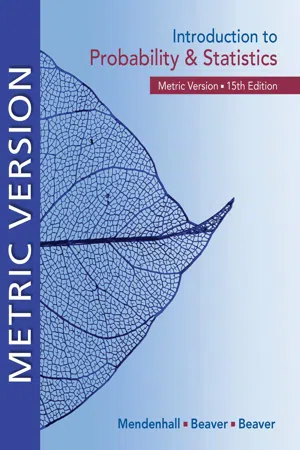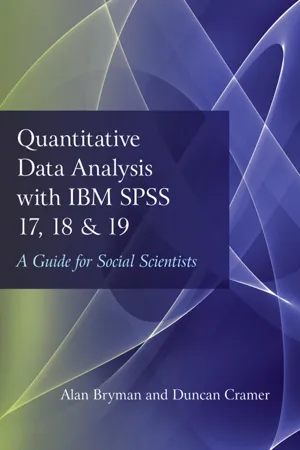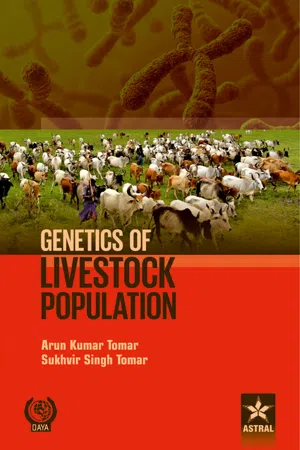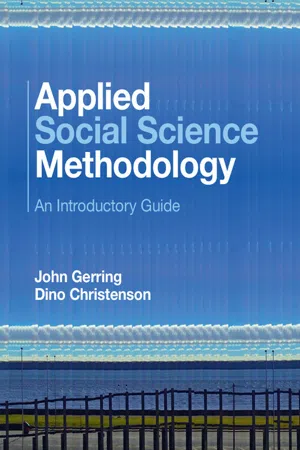Mathematics
Bivariate Data
Bivariate data refers to a set of data that involves two different variables. In mathematical terms, it represents pairs of observations or measurements for two different characteristics or factors. Analyzing bivariate data allows for the exploration of relationships and patterns between the two variables, often through methods such as scatter plots and correlation analysis.
Written by Perlego with AI-assistance
Related key terms
1 of 5
7 Key excerpts on "Bivariate Data"
- No longer available |Learn more
- William Mendenhall, Robert Beaver, Barbara Beaver, , William Mendenhall, Robert Beaver, Barbara Beaver(Authors)
- 2019(Publication Date)
- Cengage Learning EMEA(Publisher)
97 3.1 Describing Bivariate Categorical Data Introduction Very often researchers measure more than just one variable during their investigation. For example, an auto insurance company might be interested in the number of vehicles owned by a policyholder as well as the number of drivers in the household. An economist might need to measure the amount spent per week on groceries in a household and also the number of people in that household. A real estate agent might measure the selling price of a residential property and the square meterage of the living area. When two variables are measured on a single experimental unit, the resulting data are called Bivariate Data . How should you display these data? Not only are both variables important when studied separately, but you also may want to explore the relationship between the two variables . Methods for graphing Bivariate Data, whether the variables are qualitative or quantitative, allow you to study the two variables together. As with univariate data , you use different graphs depending on the type of variables you are measuring. 3.1 Describing Bivariate Categorical Data When at least one of the two variables is qualitative or categorical , you can use pie charts, line charts, and bar charts to display and describe the data. Sometimes you will have one qualitative and one quantitative variable that have been measured in two different popula-tions or groups. In this case, you can use two side-by-side pie charts or a bar chart in which the bars for the two populations are placed side by side. Another option is to use a stacked bar chart , in which the bars for each category are stacked on top of each other. ● ● Need a Tip? “ Bi ” means “two.” Bi variate data generate pairs of measurements. Are professors at private colleges paid more than professors at public colleges? The data in Table 3.1 were collected from a sample of 400 college professors whose rank, type of col-lege, and salary were recorded. - eBook - PDF
- Carl McDaniel, Jr., Roger Gates(Authors)
- 2020(Publication Date)
- Wiley(Publisher)
314 CHAPTER 14 More Powerful Statistical Methods There is definitely a shortage of people with these skills and salaries that quickly move into six figures are the norm. 2 The tools covered in this chapter are basic tools in the data scien- tist toolbox. Bivariate Statistical Analysis We have covered basic analytical and statistical methods used by marketing researchers and analysts. Now we will dive into more powerful statistical methods that can provide deeper insights into the data and give us some true analytics tools that provide bases for developing dynamic modeling capabilities and real insights. As with the items in the previ- ous chapter, those discussed in this chapter have been around for a long time. They have survived the test of time and are widely used today as workhorses in our analytical arsenal. They are even used with big data. Bivariate Analysis of Relationships In many marketing research studies, the interests of the researcher and manager go beyond issues that can be addressed by the statistical testing of differences discussed in Chapter 13. They may, for example, be interested in the degree of association between two variables. Statistical techniques appropriate for this type of analysis are referred to as bivariate techniques. When more than two variables are involved, the techniques employed are known as multivariate techniques discussed later in this chapter. When understanding the nature of the relationship between two variables is the goal, the variables are classified as the independent (predictor) variable and the dependent (criterion) variable. Independent variables are those that are believed to affect the value of the dependent variable. Independent variables such as price, advertising expenditures, or number of retail outlets may, for example, be used to predict and explain sales or market share of a brand—the dependent variable. - eBook - ePub
- John Buglear(Author)
- 2012(Publication Date)
- Routledge(Publisher)
Bivariate analysis is of great importance to business. The results of this sort of analysis have indeed influenced the hospitality and tourism sectors considerably. When the relationship between the amount of alcohol in the blood system and reaction times was established, drink-driving laws were introduced. The analysis of survival rates of micro-organisms and temperature is crucial to the setting of appropriate standards in food storage and preparation. Marketing strategies of organizations in the tourism sector are often based on the analysis of consumer expenditure in relation to age or income. Sometimes time itself is an important variable; for instance the timing of advertising and promotional activities in the tourism industry is based on the analysis of consumer expenditure over time.This chapter will introduce you to some of the techniques that companies and other organizations use to summarize Bivariate Data. The first set of techniques you will meet, correlation and regression, are general techniques that can be used with any Bivariate Data. The second set of techniques, which consists of price indices and basic time series analysis, are designed to summarize sets of Bivariate Data in which one of the variables is time.4.1 Correlation and regressionSuppose you have a set of Bivariate Data that consists of observations of one variable, X, and the associated observations of another variable, Y, and you want to see if X and Y are related. For instance, the Y variable could be sales of ice cream per day and the X variable the daily temperature, and you want to investigate the connection between temperature and ice cream sales. In such a case correlation analysis enables us to assess whether there is a connection between the two variables and, if so, how strong that connection is.If correlation analysis tells us there is a connection we can use regression analysis to identify the exact form of the relationship. It is essential to know this if you want to use the relationship to make predictions, for instance if we want to predict the demand for ice cream when the daily temperature is at a particular level.The assumption that underpins bivariate analysis is that one variable depends on the other. The letter Y is used to represent the dependent variable, the one whose values are believed to depend on the other variable. This other variable, represented by the letter X is called the independent variable. The Y or dependent variable is sometimes known as the response because it is believed to respond to changes in the value of X. The X or independent variable is also known as the predictor - eBook - ePub
Quantitative Data Analysis with IBM SPSS 17, 18 & 19
A Guide for Social Scientists
- Alan Bryman, Duncan Cramer(Authors)
- 2012(Publication Date)
- Routledge(Publisher)
Chapter 8
Bivariate analysis: exploring relationships between two variables
■ Crosstabulation■Crosstabulation with statistical significance: the chi-square (χ 2 ) test■ Correlation■ Other approaches to bivariate relationships■ Regression■ Overview of types of variable and methods of examining relationships■ ExercisesT HIS CHAPTER FOCUSES on relationships between pairs of variables. Having examined the distribution of values for particular variables through the use of frequency tables, histograms, and associated statistics as discussed in Chapter 5 , a major strand in the analysis of a set of data is likely to be bivariate analysis – how two variables are related to each other. The analyst is unlikely to be satisfied with the examination of single variables alone, but will probably be concerned to demonstrate whether variables are related. The investigation of relationships is an important step in explanation and consequently contributes to the building of theories about the nature of the phenomena in which we are interested. The emphasis on relationships can be contrasted with the material covered in the previous chapter, in which the ways in which cases or participants may differ in respect to a variable were described. The topics covered in the present chapter bear some resemblance to those examined in Chapter 7 - eBook - PDF
- Tomar, Arun Kumar(Authors)
- 2021(Publication Date)
- Daya Publishing House(Publisher)
Chapter 25 Bivariate Analysis It is also of great interest and importance to know the variation in two traits together i.e . how two random variables vary together. This helps to understand the relationship between the two traits. Any two characters may be related to each other in such a way that a change or variation in one character correspond with a particular directional change (in the same or opposite direction) in the other. For example, if there is an increase in the value of one character it may lead to either an increase or decrease in the other character. The second situation may be that the two characters may be independentof each other. Ifthe two characters havea relationship between them, it then means that there is a simultaneous change (variation) in both the characters. This simultaneous change or variation in two characters is measured in terms of covariation which indicates that the two characters vary together and have dependency on each other. Mathematically, the dependent variable Y is called the function of independent variable X, but in statistical terms the degree of this dependency (relationship or covariation) is measured by two statistical measures (statistics) known as coefficient of correlation and regression. 25.1 Covariance The measurement of the covariationisthe covariance which isthe mean product between the deviations of the two traits measured on the same individual. Uses of Co-variance (i) Indicates the direction (sign) and strength of relationship between two This ebook is exclusively for this university only. Cannot be resold/distributed. variables. (ii) Used to estimate the correlation and regression: The covariance and its measures viz . Correlation and regression which measures the association between two or more characters are also the second degree statistics estimated for a bivariate population. - eBook - PDF
Applied Social Science Methodology
An Introductory Guide
- John Gerring, Dino Christenson(Authors)
- 2017(Publication Date)
- Cambridge University Press(Publisher)
KEY TERMS • Discrete variable • Continuous variable • Marginals • Cross-tabulation (crosstab) • Sampling distribution of differences between means • Standard error of the difference between means • Parametric Key Terms 329 • Nonparametric • Semiparametric • Statistical power • Correlation • Pearson ’ s r • Absolute value • Collinearity • Construct validity • Sum of products • Sum of squares 330 Bivariate Statistics 22 Regression In this chapter we build on the concept of correlation with ordinary least squares (OLS) regression, even though the latter was invented fi rst. 188 If we think about our scatter plot, we could draw one line through the data that best fi ts all of our data points. Correlation is a statement about how close the points are to the line. The objective of regression is to determine the best fi tting line for the data. Using regression, we can determine the average effect of our independent variable and make predictions about cases outside our sample. We will begin with the simplest regression model, bivariate, where the dependent variable is a function of a single independent variable, before expanding to consider multivariate models with multiple independent variables. Bivariate Regression ....................................................................................... As social scientists we primarily want to explain why variables of interest vary and vary together. Regression allows us the ability to measure the effect of one variable on another. It tells us the effect of an independent variable on a dependent variable. Furthermore, it provides us with the degree of the effect, thereby provid-ing more explanatory leverage than in any other technique we have discussed thus far. Not unlike correlation we can fi nd the strength and direction of association between two variables. - eBook - PDF
- Maria Dolores Ugarte, Ana F. Militino, Alan T. Arnholt(Authors)
- 2015(Publication Date)
- Chapman and Hall/CRC(Publisher)
In Section 2.3, two of the methods used to gain a deeper understanding of categorical variables were tables and barplots. When two variables are categorical, tables, called contingency tables, and barcharts will still prove useful. When presented with quantitative Bivariate Data, relevant questions will deal with the relationships between the two variables. For example, is there a relationship between a person’s height and his weight? Is there a relationship between the amount of time a student spends studying and her grades? Graphical techniques such as scatterplots can be used to explore bivariate relationships. When relationships exist between variables, di ↵ erent correlation coe ffi cients are used to characterize the strengths of the relationships. Finally, a brief introduction to the simple linear regression model is given before multivariate data is covered. 2.7.1 Two-Way Contingency Tables The commands table(x) and xtabs(~x, data = DF) were used for creating frequency tables with univariate, categorical variables. For bivariate, categorical data, the commands table(x, y) and xtabs(~x + y, data = DF) are used to create two-way contingency ta-bles where x and y represent the two categorical variables and DF is a data frame containing x and y . Example 2.24 Consider the data frame EPIDURAL , which contains information from a study to determine whether the traditional sitting position or the hamstring stretch position is superior for administering epidural anesthesia to pregnant women in labor as measured by the number of obstructive (needle to bone) contacts oc . The variable doctor specifies which of the four physicians in the study administered the procedure. The physician’s assessment prior to administering the epidural of how well bony landmarks for epidural placement can be felt is stored in the variable ease . Produce a two-way contingency table for the variables doctor and ease .
Index pages curate the most relevant extracts from our library of academic textbooks. They’ve been created using an in-house natural language model (NLM), each adding context and meaning to key research topics.






